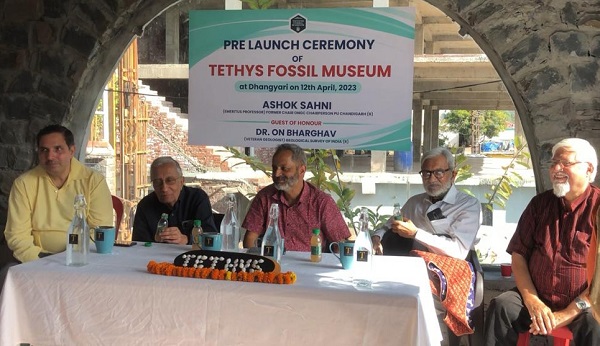Kasauli, (Samajweekly) Being built from 20 million-year-old rocks of Kasauli sandstone, Tethy’s Fossil Museum and Research Centre was pre-launched in the presence of noted geologists Ashok Sahni and O.N. Bhargava.
The centre is coming up at Dhangiari, a small village in Kasauli tehsil.
The geological museum is located on the debris concealing the Dagshai-Subathu boundary which signifies the closure of Tethys sea and evolution of terrestrial ecosystem, Ritesh Arya, founder of the Tethys Fossil Museum, told IANS on Thursday.
He said that the museum is being built from 20 million-year-old rocks of Kasauli sandstone, beautifully chiseled to give the museum an aesthetic look.
“The water which we drink in the museum is from a borewell drilled into 40 million-year-old white quartzite sandstone which is marker bed extending from Pakistan to Burma in the least,” he said.
Sahni said that the work is excellent and it will go a long way in guiding students about the advent, present and future of the world.
Researchers will certainly find this place as a repository for future critical analysis and they must visit this place, he said.
The Tethys Museum will display diverse well preserved fossils of Stromatolites Edia Cara, Trilobites, Molluscs, Ammonites, etc., from the Spiti Valley, fishes, whales, sharks and oysters from Subathu and Leh, plant remains consisting of logs of trees, leaves, flowers and roots from Kasauli and Dharamsala, and mammals from Shiwaliks.
Signifying gradual evolution of life on this planet and all are part of the museum repository, Arya said.
“So anyone visiting the museum will have a glimpse of how different fossils collected from different geological formations across the Himalayas can help rebuilt the entire paleohistory of the various events which led to the evolution and birth of the Himalayas,” he added.
Tethys was a sea once upon a time separating India from Tibet and Eurasia.
As the Indian plate moved northward, the Tethys sea squeezed and when the two plates collided the Tethyan sediments were uplifted forming the mighty Himalaya.
A lot of research has been done in timing the collision of the two plates leading to evolution and birth of the Tethyan Himalayas.
But still there is no consensus and there are Himalayan opportunities for researchers to come up with a convincing model to time the collision and explain the birth of the Himalayas.










